Abstract
Mathematical modeling describes how events, concepts, and systems of interest behave in the world using mathematical concepts. This research approach can be applied to theory construction and testing by using empirical data to evaluate whether the specific theory can explain the empirical data or whether the theory fits the data available. Although extensively used in the physical sciences and engineering, as well as some social and behavioral sciences to examine theoretical claims and form predictions of future events and behaviors, theory-oriented mathematical modeling is less common in educational technology research. This article explores the potential of using theory-oriented mathematical modeling for theory construction and testing in the field of educational technology. It presents examples of how this approach was used in social, behavioral, and educational disciplines, and provides rationale for why educational technology research can benefit from a theory-oriented model-testing approach.





Adapted from Bessière et al. (2006)

Adapted from Anderson (2011)

Adapted from Picciano (2017)

Adapted from Means et al. (2014)
Similar content being viewed by others
References
Anderson, T. (2008). The theory and practice of online learning (2nd ed.). AU Press.
Anderson, T. (2011). The theory and practice of online learning. AU Press.
Atkinson, R. C., & Schiffrin, R. M. (1971). The control of short-term memory. Scientific American, 225, 82–90.
Atkinson, R. C., & Shiffrin, R. M. (1968a). Human memory: A proposed system and its control processes. In K. W. Spence & J. T. Spence (Eds.), The psychology of learning and motivation (Volume 2) (pp. 89–195). Academic Press.
Atkinson, R. C., & Shiffrin, R. M. (1968b). Human memory: A proposed system and its control processes. In K. W. Spence & J. T. Spence (Eds.), The psychology of learning and motivation: Advances in research and theory (Vol 2) (pp. 89–195). Academic Press.
Bessière, K., Newhagen, J. E., Robinson, J. P., & Shneiderman, B. (2006). A model for computer frustration: The role of instrumental and dispositional factors on incident, session, and post-session frustration and mood. Computers in Human Behavior, 22(6), 941–961. https://doi.org/10.1016/j.chb.2004.03.015
Blömeke, S., & Kaiser, G. (2011). Homogeneity or heterogeneity? Profiles of opportunities to learn in primary teacher education and their relationship to cultural context and outcomes. ZDM Mathematics Education, 44(3), 249–264. https://doi.org/10.1007/s11858-011-0378-6
Boland, L. A. (2014). Model building in economics: Its purposes and limitations. Cambridge University Press.
Bulfin, S., Henderson, M., Johnson, N. F., & Selwyn, N. (2014). Methodological capacity within the field of “educational technology” research: An initial investigation. British Journal of Educational Technology, 45(3), 403–414.
Cilesiz, S., & Spector, J. M. (2014). The philosophy of science and educational technology research. In J. M. Spector, M. D. Merrill, J. Elen, & M. J. Bishop (Eds.), Handbook of research on educational communications and technology (pp. 875–884). New York: Springer.
Cronbach, L. J. (1975). Beyond the two disciplines of scientific psychology. American Psychologist, 20, 116–117.
Dabbaghian, V., & Mago, V. K. (2014). Theories and simulations of complex social systems. Springer.
Dym, C. (2004). Principles of mathematical modeling. Academic Press.
Ertmer, P. A. (1999). Addressing first- and second-order barriers to change: Strategies for technology integration. Educational Technology Research and Development, 47(4), 47–61.
Garrison, D. R., Anderson, T., & Archer, W. (2000). Critical inquiry in a text-based environment: Computer conferencing in higher education model. The Internet and Higher Education, 2(2–3), 87–105.
Goe, L. (2007). The link between teacher quality and student outcomes: A research synthesis. Washington, DC: National Comprehensive Center for Teacher Quality. Retrieved from http://ncctq.learningpt.org/publications/LinkBetweenTQandStudentOutcomes.pdf
Gollwitzer, P. M. (1999). Implementation intentions. Strong effects of simple plans. American Psychologist, 54(7), 493–503.
Harasim, L. (2012). Learning theory and online technologies. Routledge/Taylor & Francis.
Hew, K. F., & Brush, T. (2007). Integrating technology into K-12 teaching and learning: Current knowledge gaps and recommendations for future research. Education Technology Research and Development, 55, 223–252. https://doi.org/10.1007/s11423-006-9022-5
Hew, K. F., Lan, M., Tang, Y., Jia, C., & Lo, C. K. (2019). Where is the “theory” within the field of educational technology research? British Journal of Educational Technology. https://doi.org/10.1111/bjet.12770
Hoffman, B. (2010). “I think I can, but I’m afraid to try”: The role of self-efficacy beliefs and mathematics anxiety in mathematics problem-solving efficiency. Learning and Individual Differences, 20(3), 276–283.
Hoffman, R. (2003). Why buy that theory? In O. Sacks (Ed.), The best American science writing: 2003 (pp. 222–227). Harper-Collins.
Hollander, E. P. (1967). Principles and methods of social psychology. Oxford University Press.
Holmberg (1985). The feasibility of theory of teaching for distance education and a proposed theory (ZIFF Paiere 60). Hagen, West Germany: Fern Universitat, Zentrales Institute fur Fernstudienforscgung Arbeitsbereich. (ERIC Document Reproduction Service No. ED290013).
Huang, W.-H., Huang, W.-Y., & Tschopp, J. (2010). Sustaining iterative game playing processes in DGBL: The relationship between motivational processing and outcome processing. Computers & Education, 55(2), 789–797.
Jaccard, J., & Jacoby, J. (2009). Theory construction and model building skills: A practical guide for social scientists. Guilford Press.
Johns, G. (2006). The essential impact of context on organizational behavior. Academy of Management Review, 31(2), 386–408.
Jones, C., & Czerniewicz, L. (2011). Theory in learning technology. Research in Learning Technology, 19(3), 173–177.
Keller, J. M. (1999). Using the ARCS motivational process in computer-based instruction and distance education. New Directions for Teaching and Learning, 78, 39–48.
Keller, J. M. (2008). An integrative theory of motivation, volition, and performance. Technology, Instruction, Cognition and Learning, 16, 79–104.
Knowles, M. S., Holton, E. F., & Swanson, R. A. (1998). The adult learner (5th ed.). Butterworth-Heinemann Publishers.
Kuhl, J. (1987). Action control: The maintenance of motivational states. In F. Halisch & J. Kuhl (Eds.), Motivation, intention and volition (pp. 279–291). Springer.
Kuhn, T. S. (1996). The structure of scientific revolutions. University of Chicago Press.
Malone, T. W. (1985). Designing organizational interfaces. In L. Borman & R. Smith (Eds.), Proceedings of the CHI’85 Conference on Human Factors in Computing Systems (pp. 66–71). New York, NY: ACM Press.
Markauskaite, L., & Reimann, P. (2014). Editorial: e-Research for education: Applied, methodological and critical perspectives. British Journal of Educational Technology, 45(3), 385–391.
Mayer, R. E. (2001). Multimedia learning. Cambridge University Press.
McDonnell, L. M. (1995). Opportunity to learn as a research concept and a policy instrument. Educational Evaluation and Policy Analysis, 17(3), 305–322.
McKenney, S., & Reeves, T. C. (2014). Educational design research. In J. M. Spector, M. D. Merrill, J. Elen, & M. J. Bishop (Eds.), Handbook of research on educational communications and technology (pp. 131–140). Springer.
Means, B., Bakia, M., & Murphy, R. (2014). Learning online: What research tells us about whether, when and how. Routledge.
Means, B., Toyama, Y., Murphy, R., & Baki, M. (2013). The effectiveness of online and blended learning: A meta-analysis of the empirical literature. Teachers College Record, 115, 1–47.
Mintzberg, H. (2005). Developing theory about the development of theory. In M. Hitt & K. Smith (Eds.), Minds in management: The process of theory development (pp. 355–372). Oxford University Press.
Moore, M. G. (1997). Theory of transactional distance. In D. Keegan (Ed.), Theoretical principles of distance education (pp. 22–38). Routledge.
Moore, M. G., & Diehl, W. C. (2018). Handbook of distance education. Routledge.
Morgan, C., & Wildemuth, B. M. (2009). Questions related to theory. Applications of social research methods to questions in information and library science (pp. 40–50). Libraries Unlimited.
Nelson, R., & Winter, S. (1974). Neoclassical vs. evolutionary theories of economic growth: Critique and prospectus. Economic Journal, 84(336), 886–905.
Novak, E. (2014). Toward a mathematical model of motivation, volition, and performance. Computers & Education, 74, 73–80. https://doi.org/10.1016/j.compedu.2014.01.009
Novak, E., Daday, J., & McDaniel, K. (2018). Using a mathematical model of motivation, volition, and performance to examine students’ e-text learning experiences. Educational Technology Research & Development, 66(5), 1189–1209. https://doi.org/10.1007/s11423-018-9599-5
Novak, E., McDaniel, K., Daday, J., & Soyturk, I. (2021). Understanding student frustration with e-learning materials: Development and validation of an E-Text Frustration scale. Featured Research Paper presented at the Association for Educational Communications and Technology (AECT), Chicago, IL. November 2021.
Opp, K.-D. (1970). Theories of the middle range as a strategy for the construction of a general sociological theory. Quality and Quantity, 4(2), 243–253. https://doi.org/10.1007/BF00199565
Pearl, J. (2000). Causality: Models, reasoning, and inference. Cambridge University Press.
Picciano, A. G. (2017). Theories and frameworks for online education: Seeking an integrated model. Online Learning, 21(3), 166–190. https://doi.org/10.24059/olj.v21i3.1225
Puntambekar, S., et al. (2018). Design-based research. In F. Fisher (Ed.), International handbook of the learning sciences (pp. 383–392). Routledge.
Qian, H., & Youngs, P. (2016). The effect of teacher education programs on future elementary mathematics teachers’ knowledge: A five-country analysis using TEDS-M data. Journal of Mathematics Teacher Education, 19(4), 371–396. https://doi.org/10.1007/s10857-014-9297-0
Reeves, T. C. (2006). Design research from the technology perspective. In J. V. Akker, K. Gravemeijer, S. McKenney, & N. Nieveen (Eds.), Educational design research (pp. 86–109). Routledge.
Rodgers, J. L. (2003). EMOSA sexuality models, memes, and the tipping point: Policy and program implications. In D. Romer (Ed.), Reducing adolescent risk: Toward an integrated approach (pp. 185–192). Sage.
Rodgers, J. L. (2010). The epistemology of mathematical and statistical modeling: A quiet methodological revolution. American Psychologist, 65(1), 1–12.
Rodgers, J. L., & Doughty, D. (2001). Does having boys or girls run in the family? Chance, 14, 8–13.
Rodgers, J. L., & Rowe, D. C. (1993). Social contagion and adolescent sexual behavior: A developmental EMOSA model. Psychological Review, 100, 479–510. https://doi.org/10.1037/0033-295X.100.3.479
Rowe, D. C., & Rodgers, J. L. (1991). Adolescent smoking and drinking: Are they epidemics? Journal of Studies on Alcohol, 52, 110–117.
Scheerens, J., & Blömeke, S. (2016). Integrating teacher education effectiveness research into educational effectiveness models. Educational Research Review, 18, 70–87. https://doi.org/10.1016/j.edurev.2016.03.002
Seel, N. M. (2009). Bonjour tristesse: Why don’t we research as we have been taught? Methodological considerations on instructional technology research. Technology, Instrustion, Cognition and Learning, 6, 151–176.
Shadish, W., Cook, T. D., & Campbell, D. T. (2002). Experimental and quasi-experimental designs for generalized causal inference. Houghton Mifflin.
Shepard, R. N. (1982). Geometrical approximations to the structure of musical pitch. Psychological Review, 89, 305–333.
Siemens, G. (2004). Connectivism: A learning theory for the digital age. International Journal of Instructional Technology and Distance Learning, 2, 1–8.
Simon, H. A., & Newell, A. (1956). Models: Their uses and limitations. In D. White (Ed.), The state of the social sciences (pp. 61–83). University of Chicago Press.
Straub, D. W. (2009). Editor’s comments: Why top journals accept your paper. MIS Quarterly, 33(3), iii–x.
Suppes, P. (1978). Impact of research on education: Some case studies. National Academy of Education.
Tatto, M. T., Schwille, J., Senk, S., Ingvarson, L., Peck, R., & Rowley, G. (2008). Teacher education and development study in mathematics (TEDS-M): Policy, practice, and readiness to teach primary and secondary mathematics. Conceptual framework. Teacher Education and Development International, Study Center, College of Education, Michigan State University.
Tipton, E., & Olsen, R. B. (2018). A review of statistical methods for generalizing from evaluations of educational interventions. Educational Researcher, 47(8), 516–524. https://doi.org/10.3102/0013189x18781522
Venkatesh, V., Morris, M. G., Davis, G. B., & Davis, F. D. (2003). User acceptance of information technology: Toward a unified view. MIS Quarterly, 27(3), 425–478.
Venkatesh, V., Thong, J. Y. L., & Xu, X. (2016). Unified theory of acceptance and use of technology: A synthesis and the road ahead. Journal of the Association for Information Systems, 17(5), 328–376.
Wedemeyer, C. A. (1981). Learning at the back door: Reflections on non-traditional learning in the lifespan. The University of Wisconsin Press.
Wenger, E. (1998). Communities of practice: Learning, meaning, and identity. Cambridge University Press.
Wenger, E., & Lave, J. (1991). Learning in doing: Social, cognitive and computational perspectives. Situated learning: Legitimate peripheral participation. Cambridge University Press.
Willingham, D. (2008). What is developmentally appropriate? American Educator, 32(2), 34–39.
Zawacki-Richter, O., Bäcker, E., & Vogt, S. (2009). Review of distance education research (2000 to 2008): Analysis of research areas, methods, and authorship patterns. International Review of Research in Open and Distributed Learning, 10(6), 21–50. https://doi.org/10.19173/irrodl.v10i6.741
Zimmerman, B. J. (2001). Theories of self-regulated learning and academic achievement: An overview and analysis. In B. J. Zimmerman & D. H. Schunk (Eds.), Self-regulated learning and academic achievement. Theoretical perspectives (pp. 1–38). Mahwah.
Funding
N/A.
Author information
Authors and Affiliations
Corresponding author
Ethics declarations
Conflict of interest
The author declares that she has no conflict of interest.
Additional information
Publisher's Note
Springer Nature remains neutral with regard to jurisdictional claims in published maps and institutional affiliations.
Rights and permissions
About this article
Cite this article
Novak, E. Mathematical modeling for theory-oriented research in educational technology. Education Tech Research Dev 70, 149–167 (2022). https://doi.org/10.1007/s11423-021-10069-6
Accepted:
Published:
Issue Date:
DOI: https://doi.org/10.1007/s11423-021-10069-6




